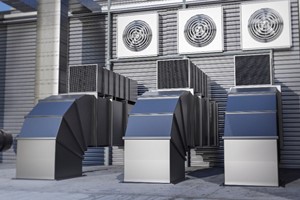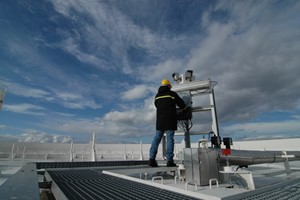Exclusive Neuroject Article: Heating, ventilation, and air conditioning (HVAC) systems are leaders in the development of sustainable practices and higher living standards in the dynamic world of modern building development. The significance of Construction HVAC systems assumes a central role as we set out on the voyage of 2023, allowing construction project managers, architects, engineers, and industry visionaries to understand its transformative powers.
Construction HVAC systems have a significant impact on a building’s energy use and environmental impact, claims the American Society of Heating, Refrigerating, and Air Conditioning Engineers (ASHRAE). At this crossroads, technology, ecological concerns, and collaborative techniques all smoothly converge.
Our thorough article aims to traverse this turning point by providing profound insights into the subtleties of Construction HVAC systems, covering design tactics, energy efficiency, installation procedures, and maintenance requirements. Stakeholders are given the tools to design spaces that symbiotically combine environmental awareness and human comfort.
HVAC Planning and Design
Building settings that seamlessly integrate occupant comfort, energy efficiency, and sustainable practices depend on HVAC planning and design. These phases, which take place in the dynamic world of contemporary building, include a cooperative effort between architects, engineers, and construction project managers to balance practical needs, aesthetic goals, and technical breakthroughs.
Understanding the purpose, size, location, and inhabitants of the structure is the first step in orchestrating the HVAC systems. The American Society of Heating, Refrigerating, and Air Conditioning Engineers (ASHRAE) asserts that careful consideration of these elements provides precise sizing calculations for heating and cooling loads, hence reducing energy waste and maximizing system performance. Utilizing BIM (Building Information Modeling) at this stage assists in the visualization and evaluation of system integration, allowing stakeholders to make final design adjustments before deployment.
Energy Efficiency and Sustainability
The discussion surrounding energy efficiency and sustainability has taken on critical importance within the field of Heating, Ventilation, and Air Conditioning (HVAC) systems in an era marked by environmental concern and resource scarcity. Modern architectural landscapes are being shaped by the necessity to balance indoor comfort with appropriate energy use and environmental stewardship as construction techniques advance.
The construction HVAC systems account for a sizeable amount of a building’s energy use, according to the American Society of Heating, Refrigerating, and Air Conditioning Engineers (ASHRAE). These systems must be designed with a sophisticated understanding of thermal dynamics, load calculations, and the integration of cutting-edge technologies if energy efficiency is to be achieved. These factors also smoothly integrate with sustainable practices, promoting an ecology where carbon footprints are reduced and inhabitants thrive in conditions with the utmost comfort.
The crucial significance of HVAC systems in reaching sustainability criteria is highlighted by green building certifications like LEED (Leadership in Energy and Environmental Design) and BREEAM (Building Research Establishment Environmental Assessment Method). This involves using creative techniques like geothermal heat pumps, solar thermal systems, and clever zoning in addition to choosing energy-efficient components.
Advanced energy modeling technologies empower architects and engineers to mimic the performance of construction HVAC systems, enabling stakeholders to make knowledgeable design decisions. This results in systems that are calibrated for maximum efficiency and customized to meet the particular requirements of each project.
HVAC System Components
The flawless regulation of indoor environments is orchestrated by the harmonious interplay of parts in the complex symphony of Heating, Ventilation, and Air Conditioning (HVAC) systems. Each component part of a construction HVAC systems performs a specific purpose and adds to the overall effectiveness, usability, and comfort of the constructed area.
Heating and Cooling Units: Heating and cooling units are essential to the HVAC systems because they keep a building at the ideal temperature. To establish thermal balance, furnaces, boilers, heat pumps, and air conditioners cooperate. Modern units improve comfort and energy conservation by including variable-speed compressors and energy-efficient designs.
Ventilation Systems: In order to maintain the best indoor air quality, ventilation systems bring in fresh outdoor air while eliminating stale inside air. This element has a significant impact on occupant health as well as limiting the accumulation of pollutants and too much humidity.
Ductwork: The circulatory system of construction HVAC systems is made up of ductwork, which makes it easier to distribute conditioned air throughout the structure. To reduce energy losses and maintain even airflow, proper duct design and insulation are crucial.
Controls and Sensors: The neural network of construction HVAC systems is made up of intelligent controllers and sensors. To enhance system performance, they track temperature, humidity, occupancy, and other factors. Real-time changes and predictive analytics are made possible by advanced controls for processes that use less energy.
Air Filtration and Purification: The state of the air must be taken into account. Healthy indoor environments are supported by filters and purification systems that capture airborne contaminants, allergies, and toxins. Modern innovations in this field include UV-C germicidal lights and high-efficiency particulate air (HEPA) filters.
Dampers and Louvers: Within construction HVAC systems, dampers, and louvers control airflow, guaranteeing even distribution and effective performance. They also provide zoning, allowing for specific temperature settings in various parts of a structure.
Refrigerant Systems: The process of heat exchange is made possible by refrigerants, which are essential to cooling systems. Low-global-warming-potential refrigerants have been created as a result of the demand for environmentally friendly alternatives and are in line with sustainability objectives.
In an era marked by rapid technological progress, the landscape of HVAC components continues to evolve. From the integration of artificial intelligence for predictive maintenance to the emergence of self-regulating systems, innovation is reshaping the HVAC domain.
Installation and Construction
In the world of construction, the orchestration of a successful Heating, Ventilation, and Air Conditioning (HVAC) system installation is a symphony of accuracy, teamwork, and technical delicacy. The crucial intersection where theory and reality meet calls for rigorous preparation, skilled execution, and seamless integration.
Construction project managers, architects, engineers, and HVAC contractors establish a dynamic alliance during this phase when collaboration emerges as the cornerstone. Interdisciplinary communication is essential to the smooth integration of construction HVAC systems into the overall building design, ensuring that ductwork, ventilation, and equipment placement complement architectural features.
To maximize performance, HVAC components must be carefully chosen and positioned. The precision in system sizing and equipment selection is stressed by the American Society of Heating, Refrigerating, and Air Conditioning Engineers (ASHRAE). Efficiency issues can result from components that are either too big or too little, underlining the importance of following established load estimations and equipment requirements.
Commissioning and Testing
Construction HVAC systems must go through crucial stages of commissioning and testing to ensure that their complex network of parts works flawlessly to provide the best performance, energy efficiency, and occupant comfort. These procedures have become more important in a time when operational excellence and sustainability are being prioritized more than ever.
In order to ensure that the construction HVAC systems is in line with the project’s goals and requirements, commissioning entails a thorough assessment of its design, installation, and operation. This thorough examination is essential for spotting any inefficiencies or anomalies early in the project schedule, preventing more expensive corrections later. The collaboration that commissioning encourages among building project managers, engineers, and technicians allows for a more comprehensive understanding of system nuances.
The cornerstone of commissioning, where the performance of HVAC components is adjusted to obtain the desired results, is testing, adjusting, and balancing (TAB). To ensure optimal performance, this procedure involves measuring and changing variables like airflow, temperature, humidity, and pressure. The subtleties of air distribution are addressed, guaranteeing homogeneity throughout the structure and avoiding problems like hot or cold patches.













